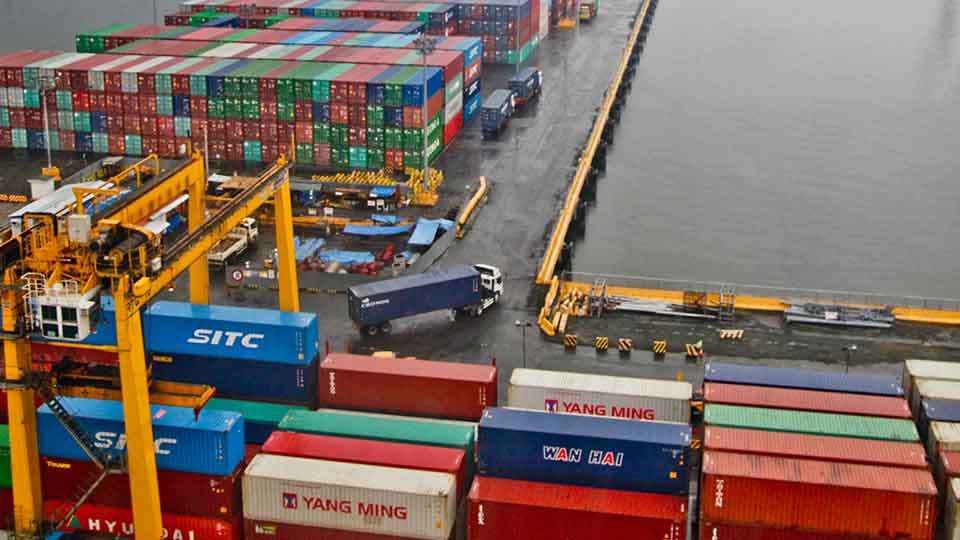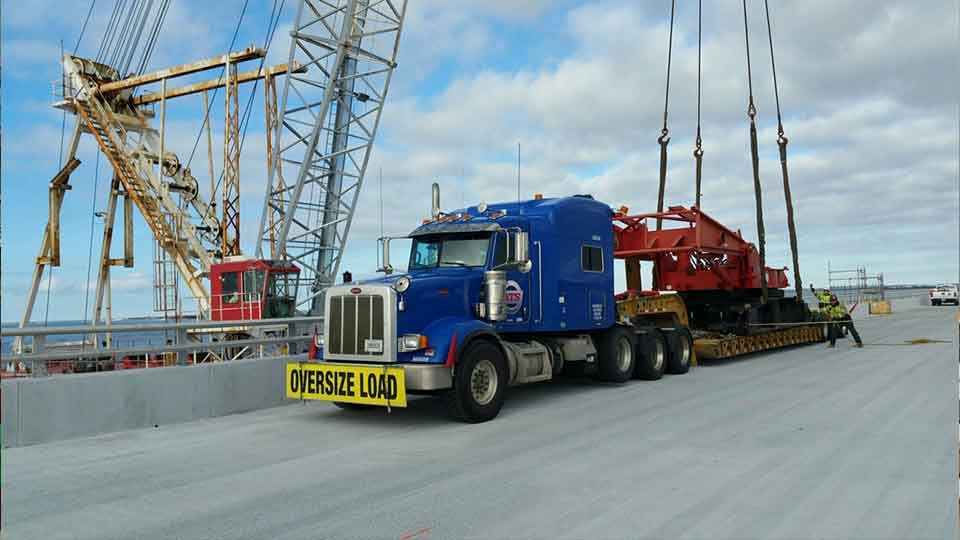
- Requirements for trucks entering ports
- Working with a customs broker
- Loading the truck
- What drayage is
- Possible timelines for port pick-ups
- The cost to move freight through a port
In a global market, there will always be demand for goods from overseas — everything from toys and clothes to fruit and furniture. No matter the commodity, all freight traveling via marine vessel has one thing in common: It enters the U.S. via a port.
Ports are a critical part of the U.S.'s infrastructure. But with millions of dollars in assets moving through ports every day, the process of transporting goods from a ship to their final destination can get complicated.
Every port has a unique set of restrictions and requirements — and exactly what those restrictions and requirements are isn’t always clear, especially to the inexperienced importer.
As a full-service carrier, Anderson Trucking Service (ATS) moves goods into and out of ports on a daily basis. Whether short- or long-haul, straightforward transport or more complex movements, our drivers have tackled virtually every challenge a port can throw their way!
This article will provide an overview of common port-shipping requirements, as well as a breakdown of loading and drayage, typical timeline estimates, and average costs.
You'll walk away with a comprehensive understanding of the port freight process, which will help you navigate your own port shipments with greater confidence. Let's get started!
Requirements for Entering Ports
Ports are secure government sites which require special identification and certifications to enter and additional paperwork to help track everything moving in and out.
The one standard document required by nearly all port authorities is the TWIC card. Other requirements are common but not universal. Before engaging a carrier to pickup or deliver freight to/from a port, be sure they understand the requirements at that location.
Here are some of the most common requirements you’ll want to be aware of when arranging pickups/drop-offs at any port.
TWIC Card
A TWIC, or Transportation Worker Identification Credential, is required for everyone who works for or at a port. This certification is required by the Maritime Transportation Security Act and administered directly by the Transportation Security Administration. Drivers who have TWIC certification have completed an extensive application process that includes a background check and personal interview. TWIC certifications must berenewed every five years.
Unlike the other common requirements, TWIC is carried by each individual driver. Drivers who have completed the TWIC certification earn a premium, which will be included on your final invoice.
UIIA Certification
UIIA stands for Uniform Intermodal Interchange and Facilities Access Agreement, a convention of port authorities who have created a standard set of guidelines for companies and vehicles entering their ports. Companies with UIIA certification are regularly inspected to ensure they meet these safety and insurance requirements.
UIIA was created to standardize port requirements and simplify the process for carriers who regularly visit multiple ports and eliminates the need for state- and port-specific inspections. While this isn’t a universally required certification, it does speak to the carrier’s commitment to safety.
UIIA is one of the more expensive credentials for port shipping. But, because it is held by the carrier company its expense is spread among many customers. Like TWIC, the upcharge for this credential is usually included in the overall shipping costs.
RFID Tags
A port-specific RFID tag attached to a window may be required to help port staff track trucks coming in and out of the port. The price for the RFID tag will vary depending on the port, usually about $50-$250.
Clean Air Program Certifications
Some ports have environmental initiatives that regulate emissions, the age of each truck/engine entering it and other factors. All trucks entering these locations will need to complete the required inspection and certification and register with the port authority before entering the premises.
Freight-Specific Paperwork
Some types of freight, such as food and beverages or hazardous materials, will require additional paperwork. This paperwork provides a chain of command for the sensitive materials to be sure they are handled properly and is similar to the paperwork required to move this type of freight domestically.
Download the Ultimate Guide to Food & Beverage Shipping.
Port Pass or Temporary Pass
Many port authorities will provide paperwork or an RFID tag the first time a driver is authorized to enter. On subsequent trips, the driver can use this authorization to enter without re-presenting their paperwork and authorization. If this is the driver’s first time at a particular port, they will need a temporary pass.
Securing a vehicle and driver to haul freight out of the port is the first step of the journey. Once a plan is in place to get the freight out of the port, it’s time to create a plan to get the freight to the truck.

Choosing a Customs Broker for Your Freight
All freight arriving at the port must be bonded or cleared through customs before release. If you are shipping bonded freight, arrangements must be made before the freight leaves its point of origin.
Non-bonded freight will need to clear customs. Although this is a well-defined process, it must be followed to the letter in order to release your freight in a timely manner. If one piece of paperwork is missing or incorrect, it will cause delays.
The process of clearing customs is greatly simplified (and sped up) if all paperwork is presented to U.S. Customs and Border Protection (CBP) neatly, in the correct order and completely filled out. While it is possible to do this yourself, an experienced customs broker who does this every day is usually a worthwhile investment.
- If you are arranging the shipment yourself, engage a customs broker. You can find a referral from an experienced importer or from the company sending your freight overseas.
- If you use a third-party logistics provider, make sure that brokering is part of your contact with them.
Your customs broker or third-party logistics provider (3PL) will gather the paperwork prepared by the shipper and receiver as well as the Bill of Lading (BOL) and present it to CBP. CBP then examines the paperwork and freight and either releases it or holds it back for further inspection. You will receive a notification when your freight is released or encounters delays.
Loading the Truck at the Port
Moving freight from the ship to the truck will be done by unionized staff. Whether breakbulk, containerized or oversize freight, the port employs stevedores and equipment so trucks are loaded to their safety specifications. Outside workers are not permitted to help with loading or unloading.
Although the truck is loaded by port employees, the truck driver is ultimately responsible for freight securement before hitting the road. Sealed transmodal shipping containers designed to travel via ship, rail or truck latch to the base of the trailer and left unopened until the freight reaches its final destination. Other types of freight are secured to the truck by the driver before they leave the port.
What Is Drayage?
A trucking service that hauls freight a short distance to a warehouse for storage or loading to another truck is called drayage. If the freight will stay on the same truck to its ultimate destination, that is considered a long haul.
During drayage, the freight is loaded to a truck and then transloaded to another truck for the next leg of its journey. The drayage truck then returns the empty shipping container to the port before draying another load to the warehouse.
Because drayage trips are short, the same truck can move four to six loads each day. This has several advantages:
- The driver is properly credentialed and experienced with that particular port, eliminating bottlenecks and saving time.
- Shipping containers are returned promptly, eliminating the fees charged for delayed containers.
- Long-haul trucks and drivers are not tied up waiting for delayed shipments.
Drayage services can be provided by full-service carriers, local drayage companies or third-party logistics providers (3PLs). If you require drayage for your shipment, be sure to specify that with your provider as early as possible to ensure your freight isn't subjected to additional delays.

How Long Does It Take to Pick Up at a Port?
Port shipping is notorious for delays. From vessels delayed by unpredictable weather conditions at sea, to labor disputes with port employees, to unavoidable customs delays, there are many moving pieces that can cause delays.
Unlike most transport services, which are billed by the mile, port pickups are often billed by the hour. It’s generally true that the nation’s busiest ports are most likely to have long delays, but slowdowns can happen in any location.
If everything goes according to plan, here are some guidelines for the time it takes at the port. These general guidelines will vary widely based on how busy the port is–in some cases, these standard times may double or triple.
- Vessel arrival: 10-day window
- Customs clearance: 12-36 business hours
- Loading the truck: 1-12 hours
- Exiting the port: One hour
Even when everything goes right, it’s wise to expect delays at port. You can minimize these delays by arranging all paperwork before the truck arrives, and by staying in regular contact with your customs broker.
Plan Ahead When Moving Freight Through a Port
In spite of the murky timelines, planning ahead is the key to success when shipping through a port. Here are three things you should prepare before your freight arrives at any port:
Prepare Your Specification
The first step to shipping success is to clearly define what you are shipping, as well as the size, shape and weight of your shipping container. This information should be called out on the delivery order and the project spec you submit to your team. An accurate specification will help your team best prepare to receive and handle your freight.
Prepare Your Team
Before the freight leaves its originating port, verify that you have completely filled out the required customs paperwork and engaged your customs broker. Determine if you will be using drayage or a long-haul driver. If you are using a freight forwarder, make sure they are engaged, prepared and have all their needed specifications.
Prepare Your Budget
Additional fees are part of international shipping. While these fees will vary depending on port and timing (busy seasons will be more expensive and more likely to experience delays), clarify the expected cost with every member of your team.
Follow the Process for Simplified Port Shipping
No matter the size of your business or freight, there’s no need to fear overseas shipping and accessing ports. While the inexperienced shipper may find moving freight in and out of a port overwhelming, understanding and following each port's restrictions makes it a predictable process.
Following the recommended steps for overseas shipping can be done by anyone who is willing to dedicate the time to understanding the particular port and the particular requirements of that location and your freight. If you prefer to work with a freight forwarder to help with your international shipping, contact ATS.




